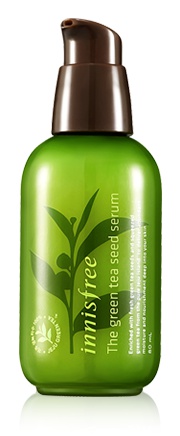
Camellia Sinensis Leaf Extract
Quick Facts
- Green tea is one of the most researched natural ingredients
- The active parts are called polyphenols, or more precisely catechins (EGCG being the most abundant and most active catechin)
- There can be huge quality differences between green tea extracts. The good ones contain 50-90% catechins (and often make the product brown and give it a distinctive smell)
- Green tea is proven to be a great antioxidant, UV protectant, anti-inflammatory, anticarcinogenic and antimicrobial
- Because of these awesome properties green tea is a great choice for anti-aging and also for skin diseases including rosacea, acne and atopic dermatitis
Geeky Details
We will tell you straight away that we are big green tea fans. Drinking it and slathering it all over your face are both great ideas. But as this is INCIDecoder and not a find-out-what’s-healthy-to-drink site we will now just focus on why you should put it on your face.
Our first reason is that green tea does not only sound good but it’s super well researched. According to one of our fav dermatologist, dr. Leslie Baumann it’s one of the most studied antioxidants. A 2015 research summary paper on green tea stated that there are about 6000 research papers on the topic currently in PubMed (the US National Library of Medicine research database).
Before we dive into what the magic powers of green tea are it’s good to know that the most useful components of the tea are called polyphenols, and even more precisely catechins. There are four major types: the most abundant and active one, the real superstar is called EGCG (EpiGalloCatechin Gallate). Also significant ones are ECG (EpiCatechin Gallate), GCG (GalloCatechin Gallate) and EGC (EpiGallo Catechin), but there are also a few more types in green tea.
To be able to truly judge the efficacy of a green tea product dr. Baumann emphasises that it’s important to know the polyphenol content of the extract used. There can be huge quality differences between various green tea extracts depending on climate, season, age of the leaf and how it was grown. (You know it’s like the tomato that you buy middle of the summer fresh from the market vs the tomato that you buy middle of the winter from a big supermarket, and it was picked totally unripe on the other half of the word a while ago - they taste totally different).
According to the 2015 research summary paper an average extract contains only 10% catechins, while Dr. Todorov of the fantastic smartskincare.com site writes about 25% (vs. only 4% in black tea). Dr. Leslie Baumann says in her Cosmetic Dermatology book that a good quality green tea extract should contain 50-90% catechins and the high-quality ones are brownish and have a characteristic odor. So if you stumble upon a green a tea product that’s brown and has a distinct tea-like smell that is a great sign of a quality product.
Ok, so now you know that not all green tea extracts are made equal and which ones are the good ones. Let’s see those magic powers.
Great Antioxidant & UV protectant
The polyphenols in green tea are strong, proven antioxidants. That’s good because they help to protect our skin against not-so-nice little things called free radicals that are out there to destroy the very nice, firming collagen in our skin. Studies show that green tea reduces UV caused skin irritation and reddening (it’s called erythema), and decreases the number of sunburn cells. It’s a great idea to use a green tea product in the morning under your sunscreen.
Anticarcinogenic
This one partly comes from the antioxidant and UV protectant properties but we wanted to emphasise that green tea does not only give some “superficial” skin benefits but is truly a health protectant. It can inhibit DNA damage and even activates some enzymes that help with DNA repair. Thanks to this it’s very useful for preventing non-melanoma type skin cancer. So especially if your skin cancer risk factors are high (fair skin, skin cancer history in the family, blue or green eyes, past sunburns, some types of moles), introducing green tea into your skin care is a fantastic thing to do.
Anti-inflammatory
Inflammation is an important process that’s a biological, protective response to not nice things that happen to our body. However too much inflammation in our skin is not good: it accelerates the aging process and it’s also behind many skin diseases (acne and rosacea the most common examples). The catechins in green tea are not only amazing antioxidants but they also possess magic anti-inflammatory powers. This makes green tea an awesome choice for sensitive, rosacea or acne prone skin.
Anti-microbial
This one is probably the least well known, but green tea also shows promising anti-microbial properties against some not-nice bacteria. This property makes green tea even more awesome for acne-prone skin. We could find two promising research paper results showing that 2% green tea lotion is effective to treat mild-to-moderate acne. Also atopic dermatitis is a skin diseases that could be improved with the help of the green tea polyphenols.
So the bottom line is this: green tea is a real superstar with magic powers that make it an awesome ingredient to almost everybody. If you are worried about anti-aging, skin cancer prevention, acne, rosacea or atopic dermatitis, it’s an excellent idea to use a high-quality green tea product in your skincare routine.
Show me some proof
- Journal Der Deutschen Dermatologischen Gesellschaft, Volume 13 (8)– Aug 1, 2015, Green tea in dermatology – myths and facts
- Seminars In Cutaneous Medicine And Surgery, , Volume 27 (3) – Sep 1, 2008, Natural Approaches to Management of Photoaging
- Dermatologic Therapy, Volume 26 (3) – May 1, 2013, The use of green tea extract in cosmetic formulations: not only an antioxidant active ingredient
- Skin Research and Technology, , Volume 15 (3) – Aug 1, 2009, Protective effects of green tea extracts on photoaging and photoimmunosuppression
- Archives of Biochemistry and Biophysics, Volume 508 (2) – Apr 15, 2011, Green tea prevents non-melanoma skin cancer by enhancing DNA repair
- Oxidative Medicine and Cellular Longevity, Volume 2012 (2012) – Jun 26, 2012 Protective Mechanisms of Green Tea Polyphenols in Skin
- Journal of Drugs in Dermatology : JDD, [2009, 8(4):358-364], The efficacy of topical 2% green tea lotion in mild-to-moderate acne vulgaris.






